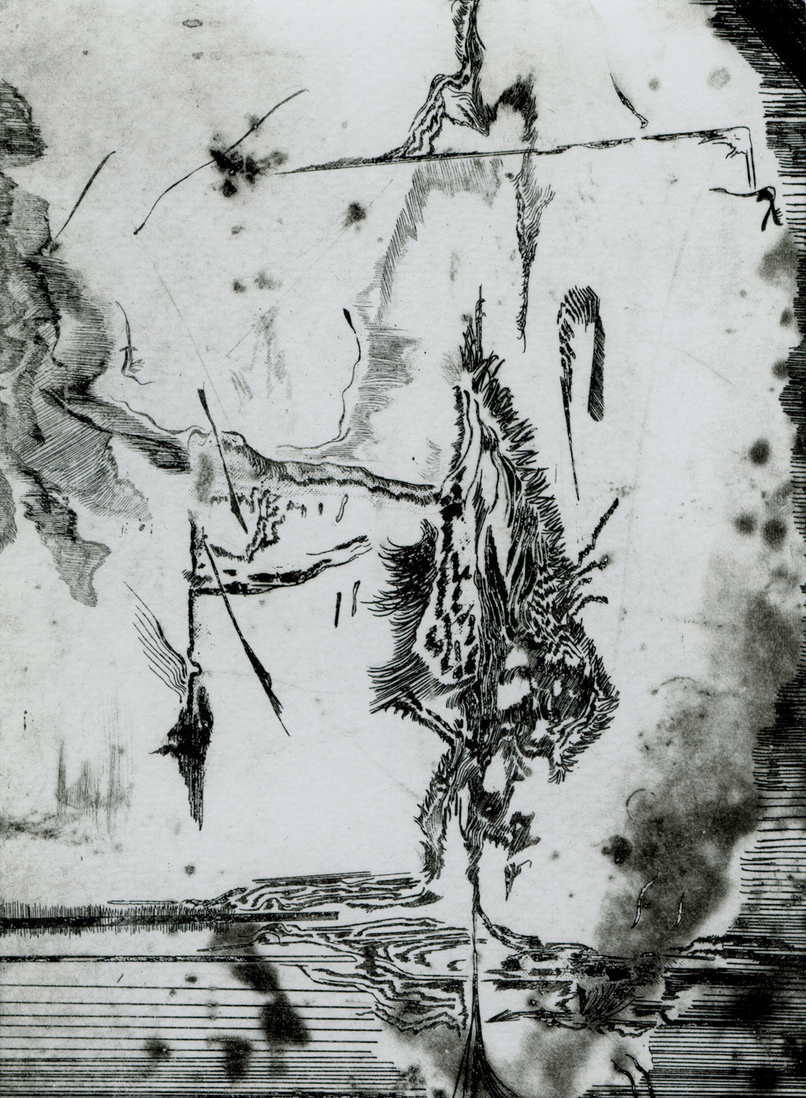Landscapes
2016 - 2024

Landscape 4 (1).—Plants in harsh desert climates have developed unique mechanisms such as compact growth habits and deep root systems. Although the sky is filled with dark clouds, it never rains. The absence of sunlight for photosynthesis exacerbates the situation, leaving everything barren and lifeless.
It is unclear whether they could have survived this drought.
It is unclear whether they could have survived this drought.
Landscape 4 (1).—혹독한 기후의 사막에서 살아가는 식물들은 좁은 면적에서 조밀하게 성장하거나 깊은 뿌리를 내리는 방식으로 진화하는 독특한 메커니즘을 발전시켰다. 머리 위에 드리워진 무거운 구름에도 불구하고 하늘은 비를 전혀 내리지 않는 것 같다. 광합성을 위한 햇빛의 부재는 상황을 악화시킨다.
그들이 이번 가뭄에서 살아남을 수 있었는지는 불분명하다.

Landscape 4(2).—A group of creatures with long, slender tendrils that sway gently in the air, drift aimlessly across the endless ocean. These seemingly weightless creatures are on a ceaseless quest to find a suitable plot of land to settle.
As they travel, their tendrils stretch out, searching for signs of solid ground or suitable spots to take root. Although no clear destination is in sight, they continue their endless wandering slowly and sincerely as they explore the vast ocean.
Landscape 4(2).—공중에 부드럽게 흔들리는 길고 가느다란 덩굴손을 가진 한 무리의 생물들이 끝없이 펼쳐진 바다를 가로지르며 정처 없이 표류한다. 아주 가벼워 보이는 이 생물들은 정착하기에 적합한 땅을 끊임없이 탐색하고 있다.
그들의 여행에서 그들의 덩굴손은 견고한 지반의 흔적이나 뿌리를 내릴 수 있는 적절한 지점을 찾으며 뻗어나간다. 뚜렷한 목적지가 보이지 않는 상황이지만, 그들은 광대한 바다를 탐험하며 느리고 진정성 있는 움직임으로 끝없는 방황을 계속한다.

Landscape 2.—Grotto
Landscape 2.—해식동굴
Landscape 2.—해식동굴


Landscape 6 (1).—On the sandy shore, there is a giant, insect-like creature with an exoskeleton that is engulfed in flames.
The creature's legs and body twitch as it tries to extinguish the fire, but it spreads quickly.
This creature has evolved to avoid water.
It may have evolved to survive by preying on other creatures living in harsh deserts or arid regions. It is unclear if it managed to survive the flame.
Landscape 6 (1).—단단한 외골격을 가진 곤충처럼 생긴 큰 생명체가 바닷가에서 불길에 휩싸여 있다. 불을 끄기 위해 다리와 몸을 경련하듯이 움직이지만 불길은 빠르게 퍼진다.
이 생명체는 물을 피하도록 진화해왔다.어쩌면 혹독한 사막이나 건조한 지역에 사는 다른 생명체를 잡아 먹으며 생존하도록 진화했는지도 모른다. 그가 불길에서 살아남을 수 있었는지는 불분명하다.

Landscape 1.—On a sea cliff with nowhere to escape, a creature resembling a tree is cornered by a predator.
Despite the howling wind, the waves crash peacefully against the rocky shore.
Despite the howling wind, the waves crash peacefully against the rocky shore.
Landscape 1.—작은 나무 같은 생명체가 바닷가 절벽에서 사나운 포식자에게 포위당했다.
이제 도망갈 곳도, 숨을 곳도 없이 궁지에 몰렸다. 바람은 울부짖지만 파도는 잔잔하게 바위 해안에 부딪힌다.

Landscape 6 (2).—The polluted haze blocked the sunlight necessary for photosynthesis. Plants could not produce the energy needed to survive, and leaves absorbed contaminants in the fog, causing damage and deformation to the cells and tissues of the plants.
Landscape 6 (2).—오염된 안개가 광합성에 필요한 햇빛이 식물에 도달하는 것을 막았다.
식물은 생존에 필요한 에너지를 생산할 수 없게 되었고, 잎사귀가 안개 속의 오염 물질을 흡수하여 식물의 세포와 조직에 손상과 변형을 일으켰다.
Landscapes is a series of ten etching plates, each printed in multiple variations, accompanied by the video work The Heaviest Burden. Each image depicts fictional creatures evolving in a world that inevitably leads to their demise, casting an existential question on the relationship between the physical self (“I”) and the world.
I created fictional organisms by synthesizing traits of humans, animals, and plants, informed by botany, anatomy, and Darwin’s theory of evolution. These imaginary hybrids inhabit a simulated world that drives them toward extinction, each image capturing a pivotal moment in their downfall. Through repeated encounters with danger and death, the creatures adapt, mutate, and evolve, reshaping their bodies and perceptions of the world. Printmaking—a medium grounded in repetition and duplication—expresses this narrative of cyclical demise.
Inspired by Nietzsche’s Eternal Recurrence (Ewige Wiederkunft), the Landscapes series forms a nuanced allegory for the recursive nature of existential suffering and the sensations that transcend it.
*The title and format of the Landscapes series are informed by the tradition of landscape etchings, particularly that of the Danube School—a collective of 16th-century artists from Bavaria and Austria renowned for their landscape etchings. My project draws upon this tradition, employing etching techniques and small-scale formats to establish a temporal connection between past and present, thus creating a paradoxical intersection of time and space through the medium.
가상의 생명체가 미지의 세계에서 죽음을 통해 진화하는 장면을 그린 Landscapes 연작은 물리적 존재인 "나"와 세계의 관계를 은유적으로 보여준다.
10개의 동판을 바탕으로 각 이미지를 다양하게 변주하는 여러 점의 에디션으로 구성된 Landscapes 연작은 진화론, 동식물의 특성, 해부학적 이미지를 바탕으로 창조된 가상의 생명체들이 그들의 죽음을 유도하도록 설계된 가상 세계 속에서 죽는 순간을 포착한다. 이들은 반복되는 위험과 죽음을 겪으며 신체적 조건을 변화시키고 그 진화는 곧 외부 세계를 인식하는 새로운 물리적 감각 체계를 만들어낸다.
생존을 위해 주변 환경에 적응하며 진화한 생명체가 다시 죽음을 맞이하는 이야기는 이미지의 복제가 가능한 판화 매체의 특성과 결합하여 계속해서 반복된다. 나의 사적인 삶, 니체의 영원 회귀 개념과 판화 매체의 특성에서 비롯하여 만들어진 Landscapes 연작은 삶을 살아가며 경험하는 되풀이되는 실존적인 불안과 그를 초월하는 감각에 대한 정교한 은유를 만들어낸다.
© Doi Kim 2024